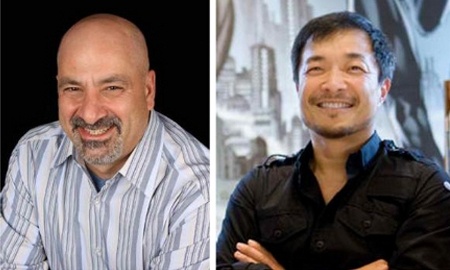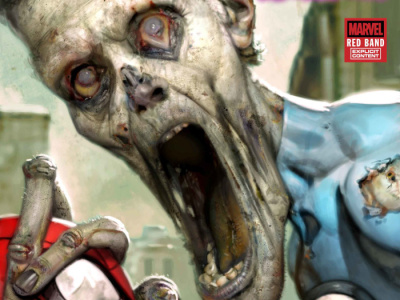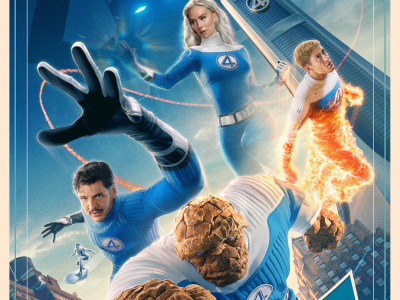We sat down with DC Co-Publishers Dan Didio and Jim Lee at New York Comic Con to catch up on DC and the fast-moving market. In Part 2, the DC co-pubs reveal their plans to reduce variants, explain the surge in sales of classic DC graphic novels, and talk about the packaging for Dark Knight 3, the digital market, and DC Super Hero Girls. In Part 1, they admit "We lost sight of our core audience," and they tell us what they’re planning to do about it.
It seems retailers are getting nervous about the number of variants and exceeds promotions. They feel like it’s getting to the point where it’s dangerous. Have you seen a change in the last few months? Is this becoming a progressively more serious issue?
Didio: I’ve found it to be harder to do variants than we have in the past. The variant buyer is being a little more discerning in their purchases. It’s more about who the artist is, what you’re doing with the art on the cover, how you’re presenting it in a unique way that really makes it feel special. Because there are so many variants out there right now from so many companies, they’re being much more careful about what they pick and choose and what they’re going to invest in.
The Dark Knight program is the first time we’ve done a retailer variant. It’s not something we’re planning to do many of. We’re not even sure when the next one will be. This seemed like the right property to do it on, and for us it was more about the level of interest. We had artists wanting to draw these characters, and retailers wanting something special to create more of an event feel in their own location.
We do themed monthly variants. There’s a couple of themes that we’ve revisited because they were successful the first time and they didn’t achieve the same level of success the second time. And we’ve done some variants that we feel did not help drive any additional sales.
So then it’s just more work.
Didio: Exactly. So what you’re finding is that you’re creating more work for yourself and it’s becoming difficult to come up with stunts just to come up with stunts. What we’re trying to do right now is be more judicious about when we do our variants. It might not be as many. We have a special stunt month in December with Harley Quinn where we’re doing these polybag variants. In the past normally we'd do about 20 books with variant covers, in this case, we’re only doing 10. We wanted to limit the number because it was a special program. We managed it to feel more special by doing it with less titles.
Our goal is to see where the variant covers make the most sense, where we think it will have the strongest impact and continue the program in those places, but where we think we’re just adding extra covers and we’re not getting that appreciable return, we’ll start to drop those out of the rotation.
We’ve heard some reaction to the opaque packaging for those Harley Quinn variants. To some, it seems like a way to get people to buy more books in order to get what they really want.
Didio: We look at it as similar to what you see with those mystery boxes or grab bags. From our standpoint, we want people to have more of the fun and surprise and shock when they open their bag and see which version they get. You want to see the fans trading books or finding books. It’s just to create more excitement in regard to how we’re presenting these covers. If somebody likes variants, then you have some fun looking at the multiple versions and finding out which one you like best. And if you don’t like variants, there’s a main cover there that’s beautifully done by Amanda Conner, at least on the Harley Quinn main book, that I think you’d be just fine with, too.
According to the BookScan charts (of the top graphic novels in the book channel each month, see "September 2015 BookScan – Top 20 Adult Graphic Novels"), DC classics are killing it. Why?
Didio: I think the simplest reason we can find is that with so much media being generated with our product, with our characters between the movies and television, we find that most of the people that are buying trades are looking for that source material.
Why are they buying The Killing Joke, for example?
Didio: Right now The Joker’s really hot. The Killing Joke last year was our best-selling hard cover, 25 years past the hill. And this year it looks like it’s going to beat the numbers it did last year.
Is it coming from the advance publicity for Suicide Squad?
I think it’s coming from The Suicide Squad. What they’re doing is looking at the various interpretations of the characters through the years and they’re identifying where they feel the one that is becoming the source inspiration for how these characters are being determined on screen. That seems to be the one getting the lift. There’s a lot of great stuff happening with The Killing Joke right now, and I think it’s a brilliant body of work that should sell well anyway, but the fact that it’s increasing in sales shows us the level of appetite for that kind of book and that story.
What do you mean by ‘that type of book’?
Didio: It’s a gritty telling of the character at origin. It feels like the definitive version of The Joker. When you see all of these multiple interpretations out there, this feels like the one that everybody goes to when you look for the purest sense of who The Joker is.
Retailers have questions about the why of the Dark Knight packaging, and especially the mini-comic. Can you tell us about that?
Lee: This all came out of conversations with Frank [Miller]. He had this creative idea, this notion of comic books being this source of wonder and amazement. The idea is when you open it up you’re brought into this amazing world, and he wanted to literally have a mini-comic fall out of the comic book, like this other little surprise to greet you as you open up a comic book.
We said, ‘That’s a great idea, we love it, but practically speaking, our retailers will revolt and we can’t do it.’ So we went down the road of investigating how can we deliver upon that idea but do it in a way that will work and not damage copies, and ensure that every copy has a mini-comic inside? We spent a lot of time looking at glue samples, how to bind it; we had to print the mini-comics in advance; there’s a lot of things we had to do. But at the end of the day, it was all worth it, it’s a really cool idea, really novel, and I think that’s what periodical print comics are all about. There’s still a lot of life and innovation left in that format, and we want to keep pushing that.
We love the ideas that are coming from the talent first because they’re coming from that authentic place of ‘hey, this is just a cool, creative idea. Let’s do it.’ And it’s our jobs as publishers and manufacturers to figure out how to bring it to life.
Did he mention Raw magazine? That’s the last place we remember seeing this done.
Lee: Probably. Frank has a lot of interesting and esoteric influences. I spent some time with him in his studio. He points to some books from Japan and from France. He really is a sponge and it wouldn’t surprise me if that’s where part of that came from.
The digital market is evolving and changing and it seems that the audiences are diverging, or at least digital seems to serve a somewhat different audience than either of the two print formats. Does DC have any research that indicates what the differences in those audiences are; what are you seeing on that issue?
Lee: I think it’s quite dependent on the books themselves. I was just talking with some of our digital partners and one of the challenges we have is that we do a really good job of servicing the fan that knows what they’re looking for when they open up an app and look for a comic book. They can search by a creator, title, or character, but if you’re new to the business and you open up one of the apps, there’s so much content and it’s not necessarily organized in a way that’s casual reader-friendly. It’s like you’re walking into a comic shop. Where do I start? So is there a better way for us to curate and introduce new readers? Ideally, you have an app that maybe reacts to a couple of questions or a survey at the beginning and it would assess how casual or hardcore a fan you were, and what your experiences or touchpoints to comics are, and then introduce you to content and then guide you through until you feel comfortable.
We still have a lot of work ahead of us in doing that. We have this amazing platform where we can deliver the content virtually instantaneously at a good price and a great reading experience, but how do we continue to make this successful to keep this growing?
I think we have all the fans that want to read comics digitally, but there are obviously other fans. Just through the Injustice sales, we’re seeing a lot of those consumers come from the videogame side. That particular comic was our number one selling digital comic book both in units and dollars last year, outselling even Batman, so obviously we’re getting fans from adjacent areas of interest, not just comic book readers, but videogame people that are interested in comics. That’s a great phenomenon to see. How do we replicate that across our comics that tie into TV shows, to the movies? So it’s not just having the content available, you’ve got to figure out how to make it appealing and palatable and market it properly.
Are you seeing any differences in the digital audience by age or gender?
Lee: We’re seeing that across individual titles like Smallville (which was discontinued). That was a really interesting title because that had a larger percentage of female readers, a large percentage of people where that was their first digital comic book that they purchased.
We see trends like that, but that’s not always the case. You could do a comic that ties directly into a TV show and it doesn’t do well, so what happened? Was the content not good? Were we not getting the message out to those fans? Or are those fans not interested in reading comics even though they like the TV show? There’s a lot of variables and moving parts. We spend a lot of time sifting through the data and trying to figure out what is the magic bullet that’s going to solve some of these. I think the answer is that it’s a different magic bullet for every property that’s out there because they all resonate with fans in different ways.
We’re very interested in your new property, DC Super Hero Girls, which is for the young girls audience, a forgotten part of the market for many years. You just announced the first original graphic novel. Can you tell us more about the publishing plans related to the property?
Didio: We have plans for an original graphic novel featuring these characters, and we’ll be showing them in ways that hopefully will give an even more mass appeal through different giveaways to really draw people to the OGN.
This isn’t just a publishing initiative; it’s a company initiative in regard to the toys, there’s going to be prose novels coming out for these characters as well, and we’re just one component of that. Granted, it’s characters that originally sprung from the DCU but it is something that we’re trying to grow to really fill this void.
Lee: It will be part of Free Comic Book Day. There will be a DC Super Hero Girls book. We expect it to play very widely and broadly.
Will the OGN be a digest format?
Didio: No, it’s regular comics size.
Will you do mass distribution or any crossover distribution with the toys?
Didio: We’re exploring all patterns right now, but the goal is to get it into as many places as possible. With Random House as our distributor, we expect these books to be in a wide variety of stores.
Click here to go back to Part 1.

Reducing Variants, Surging Classics, 'DK3,' More
Posted by ICv2 on October 22, 2015 @ 4:15 am CT
MORE COMICS
Bagged with Content Warning
June 30, 2025
Marvel Zombies: Red Band will carry a Parental Advisory content warning and come polybagged.
Showbiz Round-Up
June 30, 2025
This summer is a hot one for Hollywood news. Time for a round-up!
MORE NEWS
Company Invests Further in 'Flesh & Blood TCG' Live Event Streams
June 30, 2025
Legend Story Studios has purchased Savage Feats, a live-stream production company.
'Akhelian Tide Guard'; Also, New 'Order Battletome: Idoneth Deepkin' Incoming
June 30, 2025
Games Workshop revealed Spearhead: Akhelian Tide Guard , a new Warhammer: Age of Sigmar boxed set.








